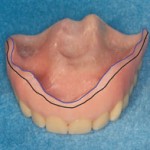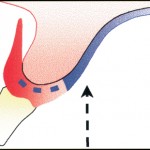Denture is a prostheses that replaces the missing tooth and the tooth supporting structures. It can either be removable, or fixed. After a denture has been worn for a long time, the shape of the base can change and no longer conform to the shape of the mouth. This can lead to loosening of the denture and resulting in discomfort. When this happens, the denture has to be remade. While waiting for the new denture to be fabricated, the base of the old denture can be changed to improve the comfort of the wearer temporarily. This procedure is known as relining. The reline material will fill the gap between the existing denture base and the surface of the oral tissue, making the denture adapted to the shape of the mouth.
If the denture is loose due to overextension, which means that the sides (also known as flanges) of the dentures are too much, relining will not be able to help. This is because relining only changes the shape of the denture base, and not the denture extensions. Â Another thing that relining cannot correct is occlusal errors. Occlusal errors are when the teeth of the upper denture and lower denture cannot bite together, or the denture will tip when the patients is grinding. This is due to wrong positioning of the teeth, and to fix this, the denture has to be remade. If relining is done to a denture with occlusal error, it will only aggravate the problem as relining will increase the height of the denture, leading to even more interference between the upper and lower teeth.
What are the requirements for denture reline material?
The ideal requirements of a relining material are:
- Life expectancy comparable to that of resin denture base
- Adhesion with denture base
- Dimensional stability (the material will not shrink or expand with time)
- Wear resistance
- Complete recovery from deformation
- Should not be affected by micro-organisms
- Non toxic, non irritable, colour stable
- Should not weaken or distort the denture base
- Easy to manipulate
However, till this day, there are no perfect material in the market that fulfills every requirement as listed above. The most commonly used materials are elastomeric polymers, heat cured or self cured plasticized acrylic resin, vinyl resins, and also polyurethane.
What are the uses of denture relining?
- To relieve areas like mental foramen or incisive papilla, midpalatine raphe, knife edged ridges, and recently surgically manipulated tissues. If a rigid dental base material is pressing onto the mental foramen or incisive papilla, it can cause patient a lot of discomfort. Similarly, knife edge ridges have very thin mucoperiosteum and will cause discomfort to the patient is a rigid dental base material is applying force onto it. Recent surgically manipulated tissues will be sore and tender, hence, by relining the denture, the resilient reline materials will apply less pressure on those tissues and allow healing to occur.
-
When surgical correction of bony undercut is contraindicated. If a rigid denture base is forced into a bony undercut, it will cause the patient much pain and discomfort. This will also lead to ulcer formation.
- In complete denture patients with parafunctional habits such as brusxism (which is grinding of teeth whether consciously, or unconsciously). This habit can apply intermittent shear force onto the mucosal tissues, which in a long term, will lead to mucosal irritation. Ultimately, bone loss will follow if this habit is still not discontinued. A resilient denture liner can protect the tissues from these excessive force as it acts as a cushion.
- To restore of congenital (which means the individual is born with the defect) or acquired (the defect occurs at a later stage of life) oral defect. The material will be placed under obturators or any prostheses used to correct the defect so that there will be retention without irritating the underlying soft tissues.
- In xerostomic (patients who secretes less saliva than normal) denture wearers, a hard denture base will keep rocking on the dry tissues. Without the protective action of the saliva, the patients will be more susceptible to irritation of the oral tissues and oral ulcer formation.
- When there is an edentulous arch opposing natural dentition and a denture liner material is used, the remaining natural teeth can be saved from extraction. This will also prevent alveolar bone loss as natural teeth can preserve the existing alveolar bone height.
It must always be remembered that denture relining only provides temporary relief, and the permanent way to fix a loose denture is by remaking the denture.

